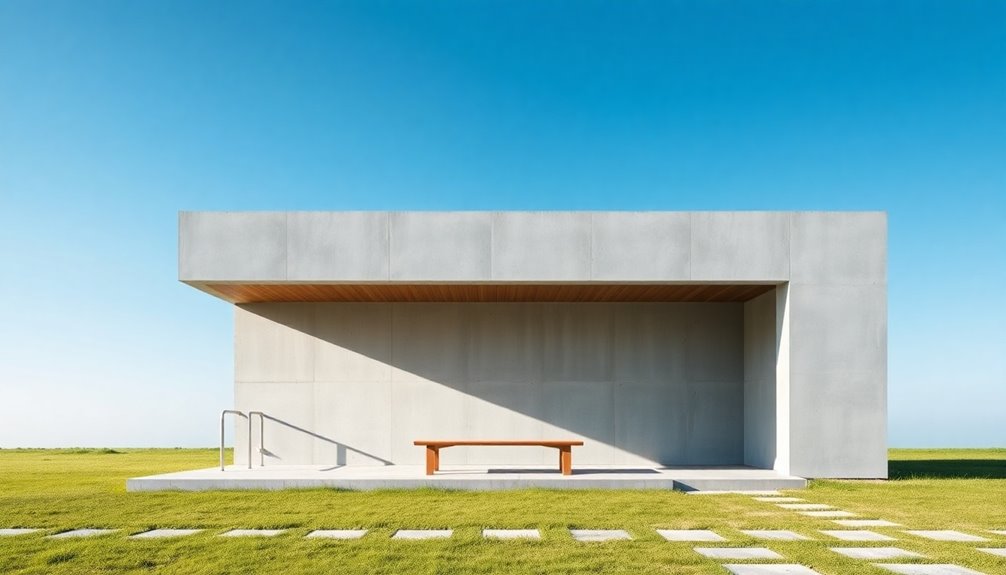Minimalist architecture captivates with its elegance, focusing on simplicity and functionality. You'll notice clean lines, open spaces, and unornamented surfaces that create a calming environment. Influenced by Bauhaus and Zen philosophy, it prioritizes natural materials and efficient design. This movement promotes mental clarity and sustainability, making it a compelling choice for modern living. Interested in how certain global examples embody these principles and what the future holds for minimalist design? There's so much more to explore!
Key Takeaways
- The minimalist movement emerged in the mid-20th century, influenced by modernism, Bauhaus, and Japanese Zen philosophy.
- Key figures like Ludwig Mies van der Rohe and Tadao Ando emphasized functionality and simplicity in their designs.
- Minimalist architecture prioritizes clean lines, neutral color palettes, and open floor plans, promoting wellness and efficient space usage.
- Contemporary minimalist designs incorporate sustainability, biophilic elements, and smart technology to enhance functionality and reduce environmental impact.
- The movement continues to evolve, emphasizing eco-friendly materials and innovative solutions like heat pumps and circular economy practices.
The Essence of Minimalist Architecture
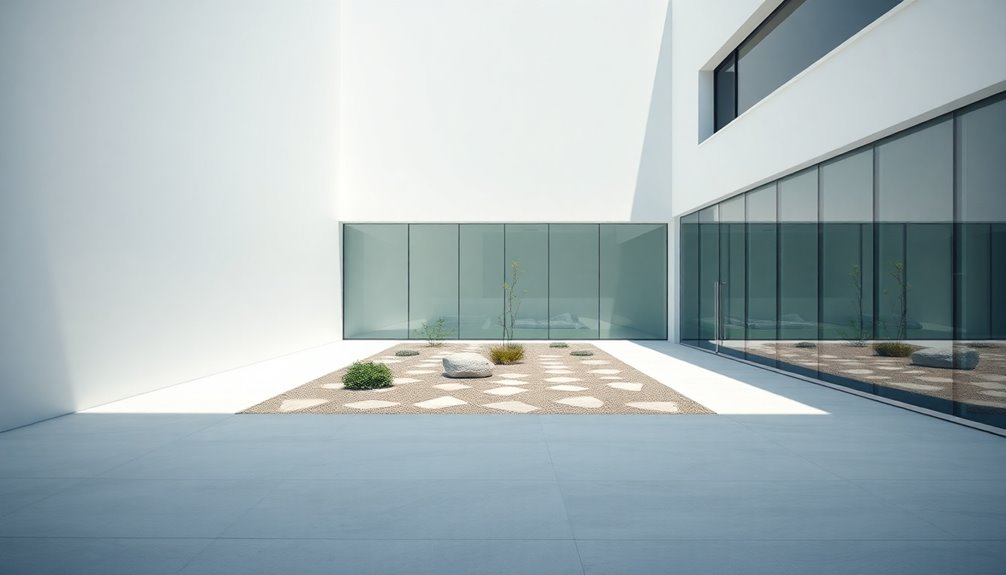
When you step into a minimalist space, you immediately notice the emphasis on simplicity and functionality that defines this architectural style.
Minimalist architecture prioritizes clean lines and unornamented surfaces, showcasing a limited palette of neutral colors. Rooted in the principle of "form follows function," every element serves a purpose, enhancing the overall experience.
Influenced by the Bauhaus movement and Japanese Zen philosophy, it celebrates essential forms and materials, allowing their inherent qualities to shine. Notable examples like Tadao Ando's Church of Light highlight transparency and light manipulation, creating a harmonious spatial experience.
Today, contemporary design continues this legacy, integrating ecological elements and sustainable practices, ensuring that minimalist architecture remains relevant and purposeful in our ever-evolving world. This approach fosters emotional regulation and a sense of calm, akin to the therapeutic benefits observed in individuals undergoing treatment for BPD.
Historical Influences and Evolution of Minimalism
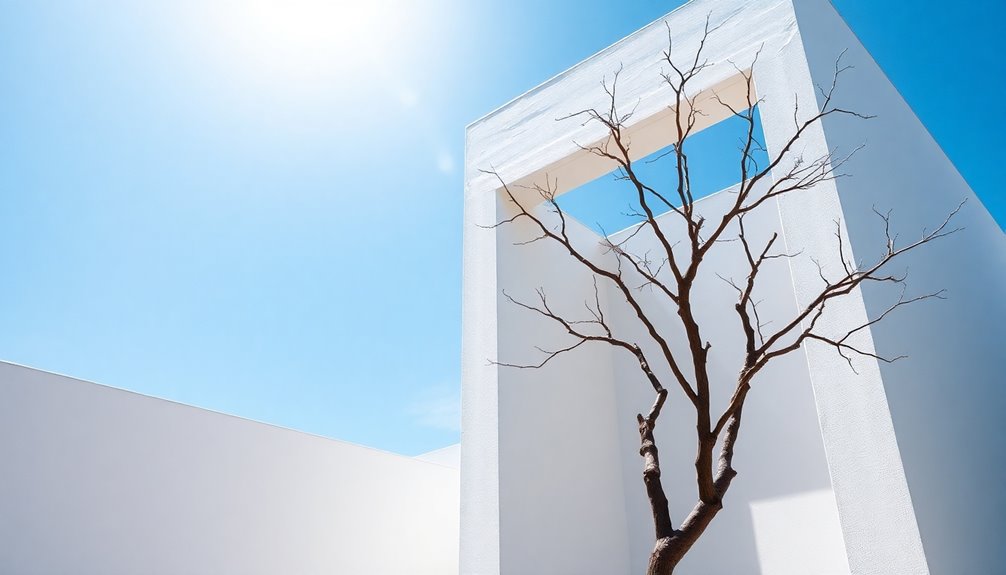
As minimalist architecture took shape in the mid-20th century, it drew heavily from modernism and the Bauhaus movement, which championed functionality and simplicity. Key figures like Ludwig Mies van der Rohe emphasized "Less is more," showcasing clean lines and open spaces. The influence of Japanese Zen philosophy further shaped the movement, advocating for simplicity and a connection to nature. Post-World War II, architects embraced minimalist designs to create efficient spaces in urban rebuilds, leading to iconic structures like the Farnsworth House. Today, minimalist architecture continues to evolve, integrating sustainable practices while maintaining a focus on essential beauty. Additionally, architects often consider tax implications of inherited IRAs when designing residential spaces that accommodate multi-generational living.
| Influences | Key Figures | Characteristics |
|---|---|---|
| Modernism | Ludwig Mies van der Rohe | Clean lines |
| Bauhaus | Tadao Ando | Function over form |
| Japanese Zen | John Pawson | Harmony with nature |
| Post-World War II | Richard Meier | Efficient spaces |
| Contemporary Practices | Bjarke Ingels | Sustainable practices |
Key Principles and Characteristics of Minimalist Design
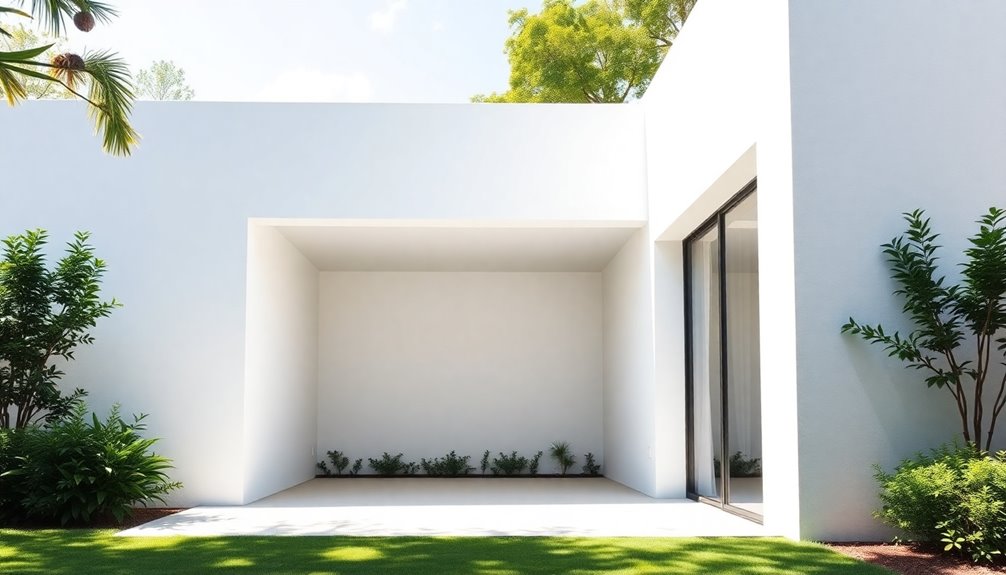
Simplicity is at the heart of minimalist design, where clean lines and unembellished surfaces take center stage. This approach in architecture prioritizes functionality and creates serene spaces that enhance your experience. Moreover, minimalist spaces can also be designed to promote wellness for families and seniors, creating environments that are both aesthetically pleasing and supportive of their needs.
Here are three key principles of minimalist design:
Three fundamental principles of minimalist design include a limited color palette, natural materials, and open floor plans.
- Limited Color Palette: Neutral tones like whites, grays, and earth tones promote a calming environment.
- Natural Materials: Using raw materials like glass, concrete, and wood highlights authenticity and honesty in design.
- Open Floor Plans: These layouts foster freedom of movement, blurring the lines between indoor and outdoor spaces.
Advantages of Embracing Minimalism in Architecture
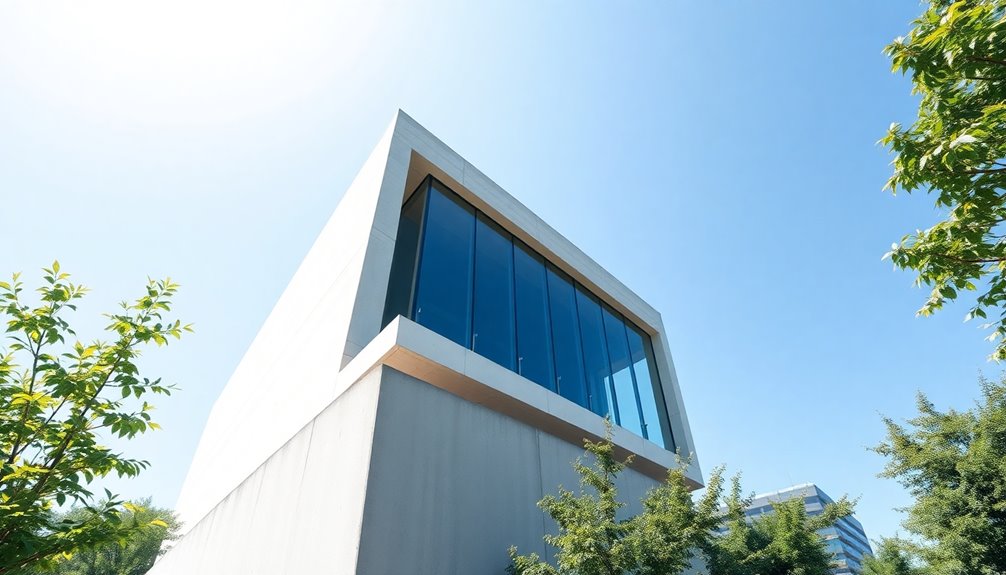
Embracing minimalism in architecture offers a range of benefits that can greatly enhance your living experience.
Minimalist architecture emphasizes a focus on simplicity, creating uncluttered spaces that promote reduced stress and mental clarity. By prioritizing efficient space usage and incorporating essential features, you find multipurpose areas that are easier to maintain.
The abundant natural light in these designs not only uplifts your mood but also lowers reliance on artificial lighting, leading to economic benefits and lower energy bills.
Additionally, minimalist practices encourage sustainable solutions, minimizing waste and fostering environmentally friendly choices. Furthermore, integrating solar energy solutions into minimalist designs can significantly enhance energy efficiency and reduce utility costs.
Notable Examples of Minimalist Architecture Worldwide
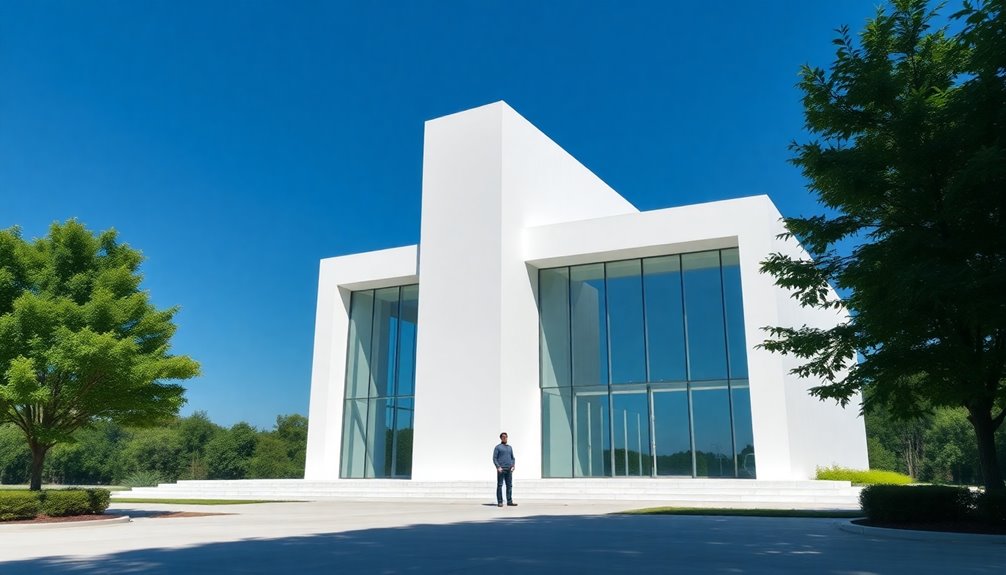
- Farnsworth House by Mies van der Rohe: This masterpiece showcases transparency and simplicity with its floor-to-ceiling glass walls, emphasizing the connection between indoor and outdoor spaces.
- Villa Savoye by Le Corbusier: It integrates nature and utility through pilotis and a functional roof garden, epitomizing minimalist ideals.
- Church of Light by Tadao Ando: Known for its dramatic use of light and concrete, this structure captures the impact of light while focusing on form and function.
These examples demonstrate how minimalist interior design can create a harmonious relationship with the environment, offering breathtaking panoramic views. Additionally, the principles of color accuracy play a crucial role in enhancing the visual quality of minimalist spaces.
The Future of Minimalism in Contemporary Design
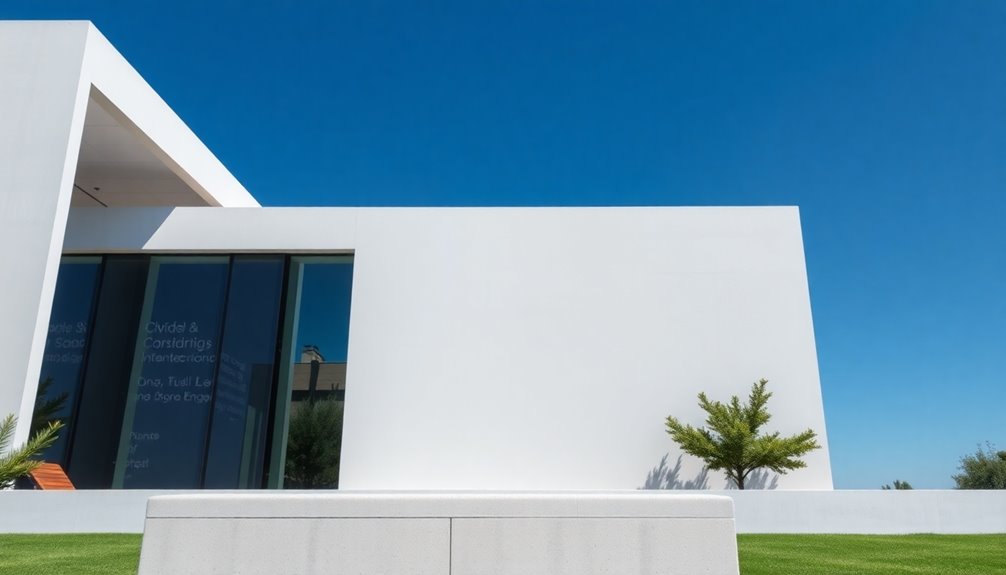
As you explore the future of minimalism in contemporary design, you'll notice a strong emphasis on sustainability. Architects are increasingly adopting eco-friendly materials and smart technology to enhance functionality without sacrificing aesthetics. This evolution reflects a broader trend towards creating spaces that aren't only beautiful but also mindful of environmental impact. Features such as sustainable materials are being integrated into designs, further promoting eco-conscious living.
Evolving Design Trends
While the principles of minimalism have long prioritized simplicity and functionality, the future of contemporary design is set to evolve in exciting ways.
As urbanization accelerates, you'll find that minimalist design increasingly embraces:
- Eco-Friendly Materials: Sustainable practices are essential, promoting reduced environmental impact.
- Flexible Spaces: Adaptable layouts cater to changing needs, emphasizing functionality in daily living.
- Biophilic Design: Large windows offer panoramic views, enhancing visual connectivity with nature.
These cutting-edge contemporary trends blend modern technology—like smart home systems—with minimalist aesthetics, creating seamless living experiences. Additionally, the incorporation of eco-friendly heating solutions can further support sustainability in minimalist design.
You'll witness spaces that not only look good but also feel good, fostering a sense of well-being while maintaining simplicity.
The future of minimalism is bright and interconnected, inviting nature right into your home.
Sustainability and Minimalism
Sustainability is becoming a cornerstone of contemporary design, particularly within the minimalist movement.
You'll find architects prioritizing eco-friendly materials and energy-efficient technologies to minimize environmental impact. By focusing on passive design strategies, like maximizing natural light and ventilation, buildings can reduce reliance on artificial heating and cooling systems.
Minimalist design often incorporates recycled and locally sourced materials, promoting a circular economy that lessens carbon footprints. Smart technology enhances functionality while keeping spaces uncluttered, supporting sustainable living. Additionally, integrating heat pumps can significantly reduce energy consumption, further enhancing the sustainability of minimalist architecture.
Emerging trends emphasize biophilic design, integrating natural elements and green spaces to foster well-being and a deeper connection to nature.
As you embrace these principles, you'll contribute to a more sustainable future through thoughtful, minimalist architecture.
Frequently Asked Questions
What Is the Minimalist Movement in Architecture?
The minimalist movement in architecture emphasizes simplicity and functionality.
You'll notice its key features, like clean lines, open spaces, and neutral colors.
This approach prioritizes practicality over ornamentation, showcasing materials like concrete, glass, and wood in their raw forms.
The design philosophy, often encapsulated by the idea that "form follows function," encourages a serene environment that eliminates excess, allowing you to focus on essential elements of the space around you.
Why Is Minimalism so Popular in Architecture?
Minimalism's popularity in architecture stems from its focus on simplicity and functionality.
You'll appreciate how open spaces and natural light create a calming atmosphere, enhancing your overall well-being.
This approach also responds to urbanization, providing efficient living solutions in crowded areas.
By using high-quality materials and promoting energy efficiency, minimalism aligns with sustainable practices, making it not just aesthetically pleasing but also practical in today's fast-paced world.
You can find beauty in less!
Who Is the Father of Architectural Minimalism?
When it comes to architectural minimalism, you can't look past Ludwig Mies van der Rohe.
Often hailed as the father of this movement, he championed the idea that "less is more." His designs, like the Farnsworth House and the Barcelona Pavilion, showcase simplicity and open spaces, demonstrating how functionality meets beauty.
Mies' influence reshaped modern architecture, emphasizing clarity and purity, leaving a lasting legacy that inspires today's minimalist architects.
Which Architect Is Known for His Minimalist Approach to Design?
When you think of architects known for minimalist design, Tadao Ando stands out. His use of concrete, light, and space creates serene environments that highlight simplicity and nature.
You might also consider Ludwig Mies van der Rohe, who famously said, "Less is more."
John Pawson, Kengo Kuma, and David Chipperfield are others who embody this approach, emphasizing clean lines, natural materials, and harmonious relationships between their structures and surroundings.
Conclusion
As you explore the minimalist movement in architecture, consider this: studies show that minimalist spaces can lead to a 30% increase in productivity and focus. Embracing simplicity not only enhances aesthetics but also promotes well-being. With its historical roots and evolving principles, minimalism continues to shape contemporary design. By stripping away the unnecessary, you can create environments that foster clarity and creativity, making the world a better place, one minimalist structure at a time.
